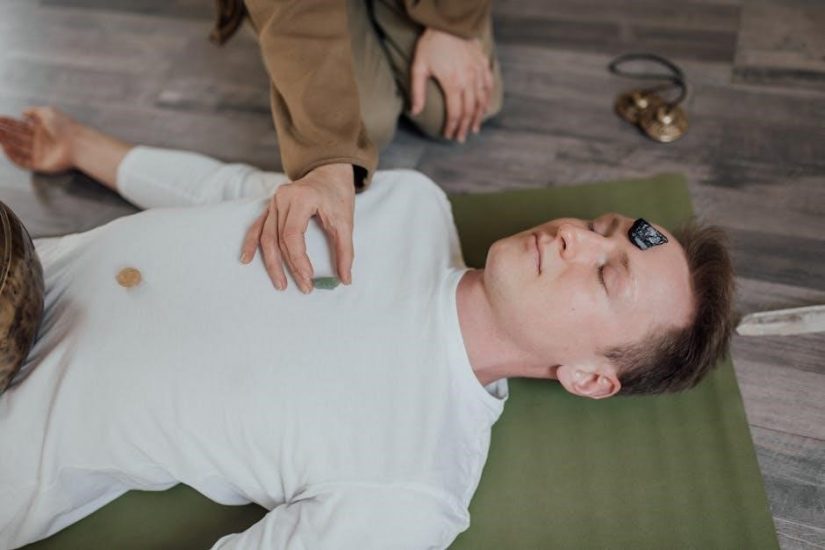In today’s chaotic world, finding peace seems challenging, but mindfulness offers a practical solution. This guide provides simple techniques to achieve inner calm and resilience, helping you stay grounded amidst life’s turmoil.
Understanding the Importance of Inner Peace
In a world dominated by constant distractions and pressures, achieving inner peace is essential for emotional and mental well-being. Without it, stress and anxiety can overwhelm, leading to burnout and dissatisfaction. Inner peace fosters resilience, allowing individuals to navigate life’s challenges with clarity and calmness. It creates a foundation for self-awareness, enabling better decision-making and healthier relationships. By cultivating inner peace, one can break free from the cycle of anxiety and unhappiness, embracing a more fulfilling and balanced life. Mindfulness practices, as highlighted in guides like Mindfulness: A Practical Guide to Finding Peace in a Frantic World, offer simple yet powerful tools to achieve this state. Inner peace is not an external destination but an internal journey, empowering individuals to find calm and contentment amidst life’s chaos.
Overview of Mindfulness and Its Benefits
Mindfulness is a powerful practice that involves being fully present in the moment, observing thoughts and feelings without judgment. Originating from ancient meditation techniques, it has evolved into a modern tool for managing stress and enhancing well-being. The benefits of mindfulness are numerous, including reduced anxiety, improved focus, and a greater sense of calm. By incorporating mindfulness into daily routines, individuals can break the cycle of overthinking and react to challenges more mindfully. As highlighted in Mindfulness: A Practical Guide to Finding Peace in a Frantic World, this approach offers practical exercises that are easy to integrate into busy lives. Regular practice can lead to lasting changes in both mental and emotional health, fostering a more balanced and peaceful existence. Mindfulness is not just a technique but a way of life, offering profound rewards for those who embrace it.

The Science Behind Mindfulness
Mindfulness is rooted in neuroscience, showing how practices like meditation reshape the brain, reducing stress and fostering calm. It leverages neuroplasticity to enhance emotional regulation and mental clarity.
How Mindfulness Reduces Stress and Anxiety
Mindfulness practices, such as meditation and breathing exercises, interrupt stress cycles by training the mind to focus on the present moment. This reduces rumination on past worries or future anxieties.
By cultivating awareness without judgment, mindfulness lowers cortisol levels, the body’s primary stress hormone. Regular practice strengthens emotional resilience, enabling individuals to handle challenges more calmly.
Techniques like body scans and mindful movement help release physical tension, a common symptom of stress and anxiety. Over time, these practices rewire the brain to respond to stressful situations more thoughtfully rather than react impulsively.
Studies show that mindfulness-based interventions can significantly reduce anxiety symptoms by teaching individuals to observe their thoughts without becoming overwhelmed by them. This creates a mental space for clarity and peace.
Overall, mindfulness offers a powerful, evidence-based approach to managing stress and anxiety, fostering a sense of calm and control in a chaotic world.
The Role of Neuroscience in Mindfulness Practices
Neuroscience plays a crucial role in understanding how mindfulness impacts the brain. Studies reveal that regular mindfulness practice can lead to structural changes in the brain, enhancing emotional regulation and reducing stress reactivity.
Neuroimaging shows increased gray matter density in areas like the hippocampus, associated with memory and emotional responses, and the prefrontal cortex, linked to decision-making and impulse control. These changes promote resilience and calmness.
The amygdala, the brain’s fear center, tends to shrink with mindfulness practice, reducing anxiety. Additionally, the default mode network, responsible for mind-wandering, becomes less active, helping individuals break free from rumination.
Such neural adaptations highlight how mindfulness reshapes the brain, fostering a more balanced and peaceful state of mind. This scientific backing underscores the transformative potential of mindfulness in achieving lasting inner peace.

Practical Techniques for Everyday Life
Meditation, mindful breathing, and physical activities like yoga and walking are simple yet effective techniques to bring calmness and clarity into daily routines, enhancing overall well-being.
Meditation: A Simple yet Powerful Tool
Meditation is a straightforward yet profound practice that can transform your life. By dedicating just a few minutes daily to mindfulness meditation, you can cultivate inner peace and clarity. This technique involves focusing on your breath or a mantra, helping you anchor yourself in the present moment. Regular meditation reduces stress, anxiety, and emotional reactivity, fostering a sense of calm and resilience. It’s accessible to everyone, regardless of belief or background, and can be done anywhere. The book Mindfulness: A Practical Guide to Finding Peace in a Frantic World offers guided meditations to support your journey. Over time, meditation not only improves mental focus but also enhances emotional well-being, allowing you to approach life’s challenges with greater ease and balance.
Breathing Exercises for Calmness
Breathing exercises are a powerful tool for achieving calmness in a frantic world. By focusing on your breath, you can anchor yourself in the present moment and reduce stress. Simple techniques like deep belly breathing or the 4-7-8 method can be practiced anywhere, offering immediate relaxation. These exercises slow down your heart rate and lower blood pressure, creating a sense of balance. Regular practice enhances emotional resilience and improves sleep quality. Incorporating breathing exercises into your daily routine, as outlined in Mindfulness: A Practical Guide to Finding Peace in a Frantic World, can help you stay calm and centered amidst life’s challenges. Over time, these practices become a natural response to stress, fostering a deeper sense of peace and well-being in your daily life.
Physical Activities: Yoga and Walking
Physical activities like yoga and walking are essential for cultivating peace in a frantic world. Yoga combines movement with mindfulness, helping to reduce stress and improve flexibility while fostering a sense of calm. Walking, especially in nature, encourages mindfulness by engaging your senses and grounding you in the present moment. Both practices promote physical well-being and emotional balance. Regular yoga practice can enhance mental clarity, while walking can boost mood and energy levels. These activities are accessible and can be incorporated into daily routines, offering a practical way to find peace amidst chaos. As outlined in Mindfulness: A Practical Guide to Finding Peace in a Frantic World, such physical practices complement mental exercises, creating a holistic approach to achieving inner peace and resilience in everyday life.

Benefits of Mindfulness Practices
Mindfulness practices foster improved mental clarity, emotional well-being, and better sleep quality, while reducing stress and anxiety. They promote resilience and help break cycles of unhappiness and exhaustion.
Improved Mental Clarity and Focus
Mindfulness practices significantly enhance mental clarity and focus by training the mind to stay present. Regular meditation and breathing exercises help reduce mind-wandering, allowing individuals to concentrate better on tasks. This increased focus leads to greater productivity and efficiency in daily activities. Additionally, mindfulness cultivates a non-judgmental awareness of thoughts, enabling better decision-making and problem-solving skills. Over time, these practices strengthen neural pathways associated with attention, making it easier to maintain focus even in chaotic environments. As a result, mindfulness becomes a powerful tool for achieving mental clarity and improving overall cognitive function, helping individuals navigate life’s challenges with greater ease and precision.
Enhanced Emotional Well-being
Mindfulness practices foster emotional well-being by helping individuals recognize and manage their emotions more effectively. Regular meditation and breathing exercises reduce emotional reactivity, allowing for a more balanced response to challenging situations. This increased self-awareness enables individuals to better understand their emotional triggers and develop healthier coping mechanisms. Over time, mindfulness cultivates a sense of compassion and acceptance, leading to greater emotional resilience. By reducing stress and anxiety, mindfulness practices also promote a more positive and stable emotional state. As a result, individuals experience improved relationships, a greater sense of calm, and an overall enhancement in their emotional well-being, empowering them to navigate life’s challenges with greater ease and confidence.
Better Sleep Quality
Mindfulness practices significantly improve sleep quality by reducing stress and anxiety, which are common barriers to restful sleep. Techniques like meditation and breathing exercises help calm the mind and body, making it easier to fall asleep and stay asleep. By incorporating mindfulness into bedtime routines, individuals can create a relaxing environment that promotes deeper sleep. Regular mindfulness practice also helps regulate sleep patterns, leading to more consistent and restorative sleep over time. Additionally, mindfulness reduces racing thoughts and worries, allowing the mind to unwind and prepare for a rejuvenating night’s rest. Over time, this leads to improved overall sleep quality, enhanced energy levels, and better physical and mental health. Mindfulness becomes a powerful tool for achieving the restful sleep essential for well-being in a frantic world.

Integrating Mindfulness into Daily Routines
Incorporate mindfulness into daily life through simple practices like mindful breathing, mindful eating, and being present in everyday activities to cultivate peace and reduce stress naturally and effectively.
Starting Your Day with Mindfulness
Begin your day with a mindful morning routine to set a positive tone. Start with a brief meditation session, focusing on your breath to clear your mind. This simple practice, often highlighted in mindfulness guides, helps reduce morning anxiety and increases energy levels. Incorporate mindful breathing exercises, such as the “4-7-8” technique, to promote calmness. Pay attention to your senses—listen to the sounds around you, feel the air on your skin, or savor the flavors of your morning tea or coffee. Even a short walk outdoors can be transformed into a mindful experience by focusing on the sensations of each step. By starting your day mindfully, you create a foundation for greater clarity, patience, and resilience, making it easier to navigate life’s challenges with grace and positivity.
Mindful Eating and Gratitude Practices
Mindful eating is a powerful practice that combines awareness with nourishment, helping you reconnect with your body and food. By paying attention to the colors, textures, and flavors of your meals, you cultivate gratitude for the simple act of eating. Start by eliminating distractions, such as turning off your phone, and savor each bite slowly. This approach not only enhances digestion but also fosters a deeper appreciation for the food you consume. Gratitude practices, such as journaling or sharing thanks aloud, can further enrich your meals. Expressing gratitude for the people, resources, and efforts that bring food to your table creates a sense of abundance and joy. These practices encourage a healthier relationship with food and life, promoting inner peace and reducing stress and anxiety. They remind us to slow down and appreciate the beauty in everyday moments.
Mindful Communication in Relationships
Mindful communication is a transformative approach to connecting with others, fostering understanding and harmony in relationships. By being fully present in conversations, you listen without judgment and respond thoughtfully, rather than react impulsively. This practice involves paying attention to both the words and the emotions behind them, ensuring clearer and more empathetic interactions. Mindfulness also encourages non-verbal awareness, such as maintaining eye contact and using open body language, which can deepen trust and connection. Additionally, it teaches patience and the value of pauses, allowing space for reflection before speaking. Regular mindfulness practice can help you navigate conflicts with grace, reducing misunderstandings and fostering mutual respect. By cultivating mindfulness in communication, you create a foundation for stronger, more meaningful relationships that contribute to lasting peace and emotional well-being. This approach reminds us that true connection begins with being fully engaged in the present moment.
Overcoming Challenges
Mindfulness helps address common obstacles like stress and anxiety, offering practical strategies to stay consistent and find emotional healing, fostering resilience in a frantic world.
Common Obstacles to Mindfulness
Many face challenges when starting mindfulness practices, such as stress, anxiety, or lack of time. Self-judgment and difficulty in quieting the mind are also frequent hurdles. Emotional triggers and unrealistic expectations can hinder progress. However, these obstacles are normal and can be overcome with patience and consistent effort. Mindfulness teaches us to acknowledge these challenges without attachment, allowing us to gently refocus on the present moment. By addressing these barriers, individuals can deepen their practice and find lasting peace in a frantic world.
Strategies to Stay Consistent
Consistency is key to mindfulness practice, yet many struggle to maintain it. Starting small, such as dedicating just a few minutes daily, can build a strong foundation. Setting realistic goals and incorporating mindfulness into daily routines, like during meals or commutes, helps maintain regularity. Using guided meditations or apps can provide structure and motivation. Mindfulness journals can also track progress and inspire reflection. Surrounding yourself with supportive communities or finding a mindfulness buddy can foster accountability. Remember, consistency doesn’t mean perfection—every moment of mindfulness counts. By making it a habit and embracing imperfection, you can stay committed to your practice and gradually experience its transformative benefits. Over time, mindfulness becomes an integral part of your life, offering calm and clarity even in chaotic moments.
Mindfulness for Emotional Healing
Mindfulness is a powerful tool for emotional healing, offering a path to recover from anxiety, depression, and trauma. By cultivating present-moment awareness, individuals can develop the skills to observe emotions without becoming overwhelmed. This practice helps break the cycle of negative thought patterns, fostering self-compassion and resilience. Regular mindfulness exercises can reduce self-criticism and increase emotional acceptance, allowing for a healthier relationship with oneself. It’s not about suppressing emotions but learning to approach them with curiosity and kindness. Over time, this leads to profound emotional healing, enabling individuals to navigate life’s challenges with greater ease and peace. Consistent practice is essential, as it strengthens emotional resilience and promotes long-term well-being. Mindfulness becomes a lifeline, guiding individuals toward a more balanced and fulfilling life.

Sustaining Peace in the Long Term
Consistent mindfulness practice, supported by community and continuous learning, helps sustain peace by navigating life’s challenges with resilience and maintaining inner harmony over time.
The Importance of Regular Practice
Regular mindfulness practice is essential for sustaining peace in a frantic world; Consistency helps break cycles of stress and anxiety, fostering emotional resilience. By dedicating just a few minutes daily to mindfulness, individuals can cultivate a sense of calm and clarity. Over time, this practice strengthens the mind’s ability to handle life’s unpredictability with grace. Regular practice also enhances self-awareness, allowing individuals to respond to challenges more thoughtfully rather than react impulsively. It creates a foundation for long-term well-being, ensuring that peace isn’t fleeting but a lasting state of being. Through commitment and patience, mindfulness becomes a powerful tool for navigating life’s chaos with serenity and focus.
Seeking Support and Community
Seeking support and community is a vital aspect of maintaining mindfulness practices. Connecting with like-minded individuals can provide motivation and accountability, helping to deepen your commitment to peace. Joining mindfulness groups, workshops, or online forums offers opportunities to share experiences and learn from others. Guided sessions with experienced practitioners can also enhance your understanding and consistency. Building a supportive network fosters a sense of belonging and encouragement, making the journey to inner peace more manageable. Additionally, sharing mindfulness practices with friends or family can create a ripple effect of calmness in your immediate circle. Engaging with a community ensures that you stay inspired and reminded of the benefits of mindfulness, even during challenging times. This collective support system plays a key role in sustaining long-term peace and well-being.
Continuous Learning and Growth
Continuous learning and growth are essential for sustaining peace in a frantic world. Expanding your knowledge of mindfulness through books, courses, and workshops deepens your practice and keeps it fresh. Exploring resources like Mindfulness: A Practical Guide to Finding Peace in a Frantic World by Mark Williams and Danny Penman provides structured guidance and inspiration. Engaging in ongoing education helps you adapt mindfulness techniques to different life challenges, fostering resilience and adaptability. Staying curious and open to new ideas ensures that your practice evolves, preventing stagnation. By committing to lifelong learning, you cultivate a mindset of growth, allowing you to embrace change and find peace amidst uncertainty. This dedication to self-improvement becomes a cornerstone of your journey toward lasting calm and fulfillment.
Summarizing the Key Takeaways
Mindfulness offers a powerful path to inner peace, even in chaotic times. By focusing on the present moment, individuals can break free from cycles of stress and anxiety. The guide emphasizes simple, practical techniques like meditation and breathing exercises to cultivate calm. Regular practice strengthens mental clarity, emotional resilience, and overall well-being. Neuroscience supports these methods, showing how mindfulness changes the brain to reduce stress and enhance happiness. By incorporating mindfulness into daily routines, such as eating and communication, one can find balance and joy. Consistency is key, and even small moments of mindfulness can lead to profound changes. Ultimately, this approach empowers individuals to transform their lives, fostering peace and happiness in a frantic world. The key takeaway is that peace is achievable through mindful living, making it a lifelong journey worth embracing.
Encouragement for Ongoing Practice
Embrace mindfulness as a lifelong journey to cultivate lasting peace. Every moment of practice, no matter how small, contributes to a calmer, more resilient you. Celebrate small victories, like noticing your breath or pausing before reacting. Consistency is key—mindfulness becomes more powerful with time, helping you navigate life’s challenges with clarity and kindness. Surround yourself with supportive communities or guided resources to stay motivated. Remember, the goal isn’t perfection but progress. Each step forward strengthens your mental and emotional well-being, bringing you closer to a more peaceful, fulfilling life. Commit to this practice, and over time, you’ll find greater joy, calmness, and harmony in the midst of a frantic world.
